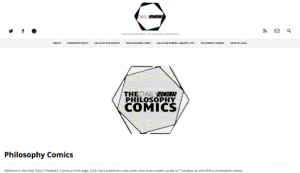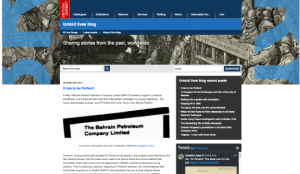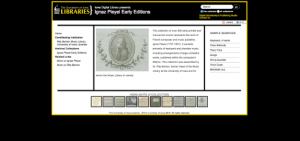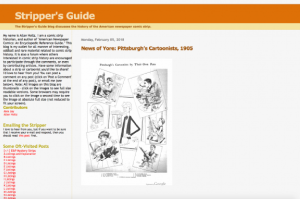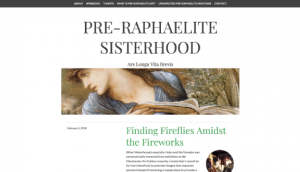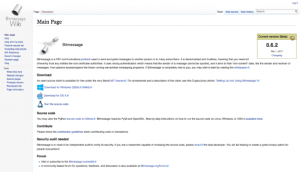Research and Education
Back to Top
|
 |
|
W.E.B. DuBois Papers
|
Social studies |
|
The University of Massachusetts-Amherst is home to the W.E.B. DuBois papers, which includes correspondence, speeches, articles, pamphlets, poetry and other items authored by the scholar and co-founder of the NAACP. In addition, the collection contains photographs, newspaper clippings, audio clips, and more. For those who can't make the trip to Amherst, the university has digitized nearly 100,000 items in this collection, which visitors can browse by type of material and by date. Included in this extraordinary collection are articles published in The Crisis; hand-written essays that DuBois penned as a student at Harvard University; and notes and clippings that DuBois used during his research. Another highlight of this collection is an audio clip of a speech DuBois gave in April 1960 before the Conference of the Association of Social Science Teachers at Johnson C. Smith University. [MMB] |
|





|
|
 |
|
 |
|
National Library of Medicine: Graphic Medicine
|
Health |
|
Through comics and graphic novels, artists are able to communicate how illness or disability impacts their daily lives and personal perspectives. The National Library of Medicine offers this online exhibit dedicated to comics about disability, health, and illness. This exhibit includes portions of Ellen Forney's graphic novel Marbles: Mania, Depression, Michelangelo, and Me; Julia Wertz's The Infinite Wait and Other Stories (which discusses the artist's diagnosis of lupus); MK Czerwiks's Taking Turns: Stories from the HIV/AIDS Care Unit 371, and much more. For health educators, this collection is accompanied by two educational resources. The first is a lesson plan designed for students between grades 7-10 and is centered on Forney's book. The second is a multi-class module designed for university-level students who are considering entering the healthcare profession. These modules allow students to explore how society and environment inform our conceptions of disabilities, consider how bias and stigmatization impact individuals with disabilities, examine how illness affects caretakers, and much more. [MMB] |
|





|
|
 |
|
EDUCAUSE: 2017 Student and Faculty Technology Research Studies
|
Educational Technology |
|
Educators, administrators, and policymakers who work in higher education settings may be interested in this series of reports and materials published by EDUCAUSE Center for Analysis and Research (ECAR) in June 2017. Collectively, these reports investigate "technology ownership, use patterns, and expectations as they relate to the student experience." These reports are based on data collected from institutions around the world. Included in this collection are a student report, which examines how undergraduates relate to technology (based on a survey of 43,559 students at 124 institutions in 10 countries); a faculty report (based on a survey of 13,451 faculty members at 157 institutions across seven countries); and a learning environment report. This last report examines student and faculty attitudes towards online learning and blended-learning environments, which combines online learning with traditional face-to-face classes. In addition to these three reports, this series includes infographics and almanacs of survey data. [MMB] |
|





|
|
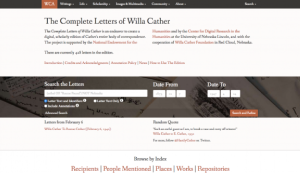 |
|
Complete Letters of Willa Cather
|
Social studies |
|
On January 16, 2018, the team behind the University of Nebraska-Lincoln's Willa Cather Archive (last featured in the 05-16-2008 Scout Report) made an exciting announcement. With support from the National Endowment for the Humanities and UNL's Center for Digital Research in the Humanities, the archive has digitized 428 letters authored by Cather. On the Complete Letters of Willa Cather page, visitors can browse these letters by recipient (who include Cather's brother, Roscoe Cather and the writer Ferris Greenslet), by people mentioned (who include Louisa May Alcott, Ernest Hemingway, and Alfred A. Knopf); by place (in reference to places listed in the letter), and by the repository in which the letter can currently be found. Each letter in the collection has been both digitized and transcribed. Best of all, the transcribed versions of these letters are also annotated, allowing readers to understand their contents with ease and learn more about the writer's life. The Willa Cather Archive plans to digitize hundreds of additional letters throughout 2018, so stay tuned. [MMB] |
|





|
|
 |
|
SpanglerScienceTV
|
Science |
|
Science teacher Steve Spangler has appeared on a variety of television shows, including regular appearances on Denver, Colorado's KUSA 9 News and a number of guest appearances on Ellen. On this YouTube channel, which might especially appeal to elementary school teachers, after-school teachers, and youth workers (as well as anyone young at heart), visitors can check out these short, televised lab activities. Many of these experiments can be replicated in a classroom. For example, in one recent video, Color Milk Explosion, Spangler demonstrates how one can create a gorgeous marbling pattern using milk, food coloring, and a cotton ball soaked with dish soap. Why? Dish soap is attracted to the fat in the milk, causing the food coloring in the milk to move. Other videos in this collection are not appropriate for reproducing in the classroom (in fact, one playlist is entitled "Don't try this at home!"), but can be enjoyed from afar. [MMB] |
|





|
|
 |
|
Research in Action Podcast
|
Educational Technology |
|
From Oregon State University's Ecampus Research Unit comes the Research in Action (RIA) podcast, which is dedicated to "topics and issues related to research in higher education." Each episode of this podcast features a guest scholar who discusses their research process, often focusing on a particular methodology that may be of interest to emerging researchers. For example, in one recent episode Stephanie Evergreen, the author of Presenting Data Effectively, talks about data visualization. In another recent episode, media studies scholar and prolific author Jolie Jensen shares her ideas about overcoming writer's block. As of this write-up, the podcast features interviews with no fewer than 90 scholars. Each episode is available in audio format and as an interview transcript. Interested listeners may subscribe to this podcast via RSS, iTunes, or SoundCloud. Each episode is also accompanied by an instructor guide, which offers ideas about how to incorporate episode content into the classroom. [MMB] |
|





|
|
 |
|
DPLA: Two Hundred Years on the Erie Canal
|
Social studies |
|
The Erie Canal, which was built between 1817 and 1825, had a profound impact on the economy and daily life in nineteenth-century America. The Digital Public Library of America (DPLA) recently launched this exhibit dedicated to the Erie Canal. This new exhibit, curated by Heidi Ziemer and Dan Ward from the Western New York Library Resources Council, in collaboration with the Empire State Digital Network, invites visitors to engage in a number of primary documents that illuminate the canal's history. For instance, in the plans and early concepts section, visitors can view the 1792 account book of Philip Schuyler, who founded the Western Inland Lock Navigation Company. In a 1796 report to the New York Legislature, the company argued that construction of a canal would present, "the prospect of a speedy reduction of the price of transportation, would doubtless greatly enhance the value of the property of the people of this state..." Other topics covered in this exhibition include the construction of the canal ("Building the Canal"), the impact of the canal on popular culture ("Canal Culture"), and insights into how the canal facilitated migration and, by extension, the culture and politics of upstate New York ("Moving People and Ideas"). [MMB] |
|





|
|











